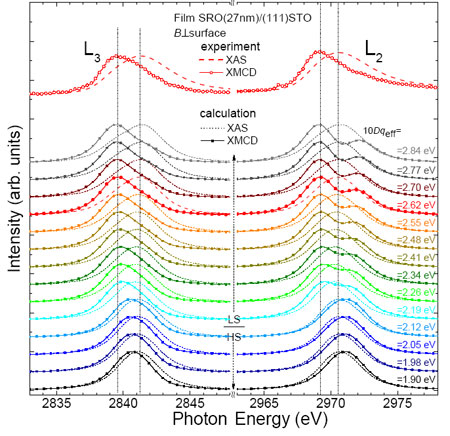SrRuO3 is one of the few known 4d transition-metal oxide ferromagnets with a Curie temperature as high as 160 K. Its rare physical properties have raised the interest of the scientific community during the last fifty years and recently also of the applied science sector due to its capacity for being used as an electrically conducting layer within magnetic heterostructure devices as used in storage technologies.
In this study, researchers have grown strained SrRuO3 thin layers on (001)- and (111)- oriented SrTiO3 substrates and compared them with unstrained SrRuO3 single crystals. The technology for growing SrRuO3 thin layers on (001) oriented SrTiO3 substrates is well known. However, the systematic growth of thin films on (111)-oriented SrTiO3 substrates is very recent.
Using synchrotron light from the BOREAS beamline, researchers wanted to determine if the compressive strain from the SrTiO3 substrate can indeed induce a spin state transition of the Ru4+ cations (i.e., from S=1 to S=2) and if the Ru orbital magnetic moment is quenched (i.e., close to zero). Although the latter orbital magnetic moments are usually small, they can have a considerable influence on the anisotropic properties of magnetic systems. To this end, X-ray magnetic circular dichroism (XMCD) studies of the Ru L2,3 absorption edges were performed.
Results show that for the strained as well as the unstrained samples the Ru orbital moment is close to zero and that the Ru spin (and thus the associated spin magnetic moment) is close to the low-spin value of S=1, as could be verified using theoretical calculations on the shape of the Ru L2,3 absorption spectra (see Fig. 1).

Fig. 1: Experimental (top) and simulated (bottom) Ru L2,3 X-ray absorption (XAS) and X-ray magnetic circular dichroism (XMCD) spectra (the sign of the experimental L3 XMCD spectrum has been reversed for clarity). The latter theoretical spectra show a transition from the S=2 high spin (HS) to the S=1 low spin (LS) state of the Ru atoms as a function of the ligand crystal field. The best agreement between experiment and theory is obtained for a Ru crystal field strength of 2.62 eV (solid and dotted red lines in bottom part).




